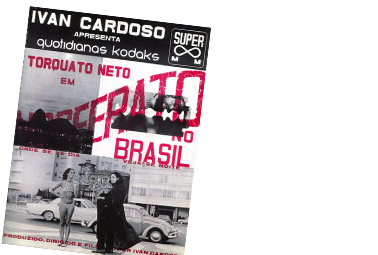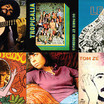Ruídos pulsativos

Marginália
At the end of the 60s, Brazilian cinema was going through one of its decisive moments. The rise of ‘cinema marginal’ (‘alternative cinema’) and the expansion of Super 8 were, during this period, the hot topics of debate amongst film directors of different generations. Adding fuel to these dilemmas, were factors such as the expansion of their marketplace (the cinemas, cinema clubs and film-going public), the gradual transformation of ‘cinema nova’-style films, by one director, to moviemaking as an industry, and the founding of the state-funded Embrafilme (Empresa Brasileira de Filme) in 1979.
Alternative cinema and Super 8 cameras hit the Brazilian film-making scene at a moment of impasse. With the splitting of Brazilian film makers into those who dated from the ‘cinema novo’ period and the group known as ‘cinema marginal’, the new camera symbolized a declaration of independence for penniless directors. As a camera – and a filming technique – the Super 8 was used by numerous filmmakers and artists in the 70s. Its use and dissemination was, literally, an alternative form of film production. The low costs and convenience, both for filming and for processing, transformed this camera into one of the tools of Brazil’s alternative cinema during this period.
‘Cinema marginal’ began with two films shot in Sao Paulo at the very end of the 60s: A Margem (The Edge), by Ozualdo Candeias, and O Bandido da Luz Vermelha (The Red Light Outlaw), by Rogério Sganzerla. Films along the same esthetic lines were subsequently launched by other directors, including Neville de Almeida, José Agripino de Paula, André Tonacci, Julio Bressane, Eliseu Visconti and Álvaro Guimarães. The whole ethos of ‘cinema marginal’ became more substantial when Sganzerla and Julio Bressane set up a film company called Belair, free from the limitations of ‘Cinema Novo’ and from Embrafilme policies. In one year, they produced six low-budget films.
The underground press of the time was always very supportive of the dissemination of Super 8. But the pioneer of the subject was Waly Salomão’s column in the Plug supplement of the Rio newspaper, Correio da Manhã. Throughout 1971 this column, entitled “Super frente super-oito”, (“Super front Super 8”) served as a form of tribune for the new filmmakers and one of the main channels for engaging in cultural discourse at the time. His character, the “Super 8 Magnate”, encouraged readers to experiment with this new technology and banish many of the old taboos from the practice of filmmaking.
Waly’s column was the impulse for Super 8 to become a legitimate form of filmmaking in Brazil.
Not only a regular topic in the press, Super 8 filmmaking also began to be part of everyday life for more and more people. Artists such as Rubens Gerchman, Carlos Vergara, Hélio Oiticica and Lygia Pape; singers and songwriters such as Galvão, Capinan, Jorge Mautner and Jards Macalé, besides Waly Salomão and Oiticica himself, started making films in Super 8 (and other formats) and broadcasting their opinions and pronouncements on Brazilian filmmaking.
Outstanding among Super 8 work from this period were films made by the Rio filmmaker Ivan Cardoso. Several of his films, Nosferato no Brasil (Nosferato in Brazil), Sentença de Deus (God’s Judgment) and A Múmia volta a atacar (The Mummy Attacks Again) – all from1972 – were shown on alternative circuits and in cinema clubs. Torquato Neto playing the vampire Nosferato is one of the iconic images of the period. Apart from acting in a number of films, Torquato was also a champion and permanent champion of Super 8 and alternative films in his column “Geléia Geral” (“General Jam”). He himself made a Super 8 film in Teresina, called “Terror da Vermelha” (“Red Terror”).
Super 8 quickly passed into obsolescence as soon as the videocassette and other filming methods arrived. Nevertheless, in the 1970s its democratic and inventive use was fundamental for the expansion of filmmaking and for the continuation of experimentalism in Brazilian cinema.























